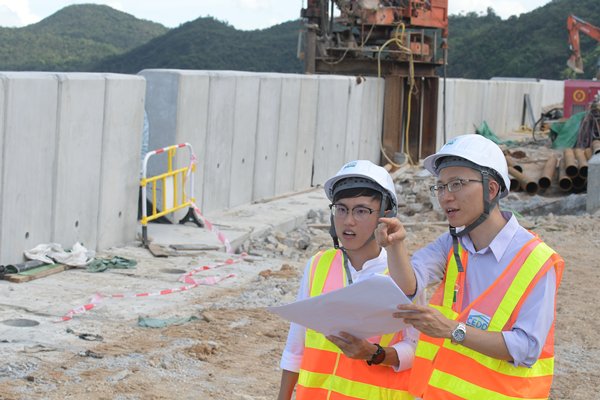Govt Bolsters Storm Defence

In the space of just a couple of years, two super typhoons - Hato and Mangkhut - lashed Hong Kong, causing widespread damage.
To be better prepared to handle future typhoons and extreme weather conditions, the Civil Engineering & Development Department has introduced new survey technologies and carried out improvement works of marine facilities.
Fully equipped
The department sends its survey vessel to inspect marine facilities like seawalls and breakwaters regularly.
New survey technologies have been installed on board the vessel such as the Integrated Multibeam Echo Sounder & Laser Scanner System which can visualise data being captured in real-time from both above and below the waterline.
The Multibeam Echo Sounder works by transmitting a fan of sound pulses to measure the shape of a marine facility underwater, while the Laser Scanner System measures the terrain above water level.
“After combining the data set, we are able to portray a clear 3D model of the marine facilities. By inspecting the 3D point cloud model, we are able to determine if there is any significant defect in the marine facilities,” Civil Engineering & Development Department Land Surveyor Tim Cheuk explained.
The Imaging Sonar System is also deployed to gather images for underwater inspection.
Its remote-controlled rotatable 2D sonar view can produce high-resolution images to identify damaged structures, so the department can arrange for follow-up action.
“The advantage of the Imaging Sonar System is that it can see through the underwater conditions, even in zero visibility.
“It transmits an echo and then receives the return and turns it into a digital signal so that we are able to capture the high resolution close-range video of the marine facilities,” added Mr Cheuk.
The department introduced these new technologies after super typhoon Hato hit Hong Kong in 2017, to enhance the efficiency and effectiveness of underwater inspections of marine structures.
The technology was especially useful following the passage of super typhoon Mangkhut last year.
“After super typhoon Mangkhut, we put this system into real use.
“We carried out several emergency surveys to inspect the damaged seawalls to review the extent of damage. This information is valuable for our engineers to propose remedial works afterwards,” said Mr Cheuk.
Fortified facilities
After Mangkhut hit, a 50m-long vertical seawall at the Sai Kung Sewage Treatment Works collapsed.
The Civil Engineering & Development Department not only helped with the emergency repairs, but also carried out strengthening works for the damaged seawall.
“To protect the Sai Kung Sewage Treatment Works from the attack of a typhoon in future, we are now carrying out the strengthening works of the seawall.
“The works include the replacement of larger rock armour units and the erection of a 1.5m-high wave wall,” Civil Engineering & Development Department Engineer Ivan Ho explained.
He added that the new wave wall can help prevent seawater influx into the sewage plant during a typhoon, while the reinforced seawall can withstand huge waves.
Based on the experience gained from Mangkhut, the department is also building a wave wall along Tseung Kwan O Waterfront Park, which was left badly damaged by the typhoon.
Civil Engineering & Development Department Senior Engineer Clarence Chan said the 600m-long wave wall is being constructed at a level of about 6.6m above the Principal Datum - the level to which tide heights are referenced in Hong Kong.
“We anticipate the wave wall can alleviate the impact on onshore residents and facilities by overtopping waves generated by the typhoon.
“The wave wall is about 1.1m above ground level. It can withstand overtopping waves without compromising the public expectation of enjoying the sea view,” Mr Chan added.
Long-term measures
To assess the impacts of extreme weather, the department has commissioned a consultant to review comprehensively low-lying coastal and windy locations, and carry out investigations on storm surges and waves.
Based on the findings, the Government will formulate protection measures to enhance the resilience of vulnerable coastal areas to stronger wave attacks.
The department will work with the Hong Kong Observatory on other climate change studies, as well as update the current design standards with reference to the Intergovernmental Panel on Climate Change’s reports, to protect public safety.
New Hub Helps Green Tech To Flourish
Last month, the Hong Kong Science & Technology Parks Corporation, or HKSTP, transformed its InnoCentre in Kowloon ... Read more
MICE Tourism Gains Momentum
Ballroom inspections and mahjong sessions may not be what automatically springs to mind when you consider Hong Kong’... Read more
Game Startups Reach New Level
The global video game industry is highly competitive, requiring effective marketing for success. The Hong Kong Game En... Read more
Breast Milk Donations Save Lives
Last April, Ida Chan welcomed her son into the world. He was born a kilogramme lighter than expected, and Ida decided ... Read more
HK Reaches For The Moon
The beauty and mystery of the Moon have captivated the human imagination for millennia. Channelling that fascination i... Read more
Creating Disability-inclusive Jobs
Nestled in the Museum of the War of Resistance & Coastal Defence, Madam Hong Cafe enjoys the spectacular views of ... Read more

